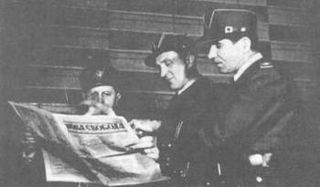
Babi Yar is a ravine in the Ukrainian capital Kiev and a site of massacres carried out by German forces and local Ukrainian collaborators during their campaign against the Soviet Union in World War II. The first, and best documented, of the massacres took place on 29–30 September 1941, killing approximately 33,771 Jews. The decision to kill all the Jews in Kiev was made by the military governor, Major-General Kurt Eberhard, the Police Commander for Army Group South, SS-Obergruppenführer Friedrich Jeckeln, and the Einsatzgruppe C Commander Otto Rasch. Sonderkommando 4a soldiers, along with the aid of the SD and SS Police Battalions backed by the Ukrainian Auxiliary Police carried out the orders.

Rumbula is a neighbourhood of Riga located in the Latgale Suburb, on the right bank of the Daugava river. With a population of about 368 inhabitants in 2010, Rumbula's territory covers 6.978 km2 (2.694 sq mi).

The Kyiv Bandurist Capella is a male vocal-instrumental ensemble that accompanies its singing with the playing of the multi-stringed Ukrainian folk instrument known as the bandura.

Mykhailo Pavlovych Teliha was an active Ukrainian community leader and distinguished musician. He was born in the Akhtyrka Stanitsa in the Kuban. It is here that he first became interested in playing the bandura in 1913. He trained initially as a forester and engineer and later he completed medical studies to become a doctor.

The 1961 Kurenivka mudslide took place on March 13 in Ukraine’s capital city of Kiev.
Kabayda Anatoly (Кабайда Анатолій a.k.a. Anatolij Zukiwskyj a.k.a. - Medvid was a Ukrainian community and political activist.

Baikove Cemetery is an historic cemetery memorial in Holosiiv Raion of Kiev, Ukraine. It is a National Historic Landmark of Ukraine and is known as a necropolis of distinguished people. It was established in 1833. Among the buried, it includes Mykhailo Hrushevskyi, Lesya Ukrainka, Slava Stetsko, Viacheslav Chornovil, Oles Honchar, Ivan Nechuy-Levytsky, Olena Pchilka, Mykhailo Starytsky, Oleksandr Bilash, Ostap Vyshnya, Ivan Mykolaychuk, Volodymyr Shcherbytsky, Leonid Telyatnikov, Mikhail Vaschenko-Zakharchenko, Oleg Antonov and Valeri Lobanovsky.

Ivan Rohach was a Ukrainian journalist, poet, writer, and political activist born in Velykyi Bereznyi, Ung county, Austria-Hungary.

Syrets concentration camp was a Nazi concentration camp established in 1942 in Kiev's western neighborhood of Syrets (Сирець), part of Kiev since 1799. The toponym was derived from a local small river. Some 327 inmates of the KZ Syrets were forced to remove all traces of mass murder at Babi Yar.

The Holocaust in Ukraine took place in Reichskommissariat Ukraine during the occupation of the Soviet Ukraine by Nazi Germany in World War II. Between 1941 and 1944 more than a million Jews living in Ukrainian SSR were murdered as part of Generalplan Ost and the Final Solution extermination policies.

Babi Yar, a ravine near Kiev, was the scene of possibly the largest shooting massacre during the Holocaust. After the war, commemoration efforts encountered serious difficulty because of the policy of the Soviet Union. After the dissolution of the Soviet Union, a number of memorials have been erected. The events also formed a part of literature.
Poems about Babi Yar commemorate the massacres committed by the Nazi Einsatzgruppe during World War II at Babi Yar, in a ravine located within the present-day Ukrainian capital of Kiev. In just one of these atrocities – taking place over September 29–30, 1941 – Jewish men, women and children numbering 33,771 were killed in a single Einsatzgruppe operation.

Dina (Vera) Mironovna Pronicheva was a Soviet Jewish actress at the Kiev Puppet Theatre, and a survivor of the September 29–30, 1941 Babi Yar massacre in Kiev.

Liudmila Titova was a Jewish-Ukrainian poet from Kiev, wife of the poet Ivan Yelagin also from Kiev, whom she had first met as a schoolgirl. Her famous poem "Babi Yar" written in 1941 – discovered only in the 1990s – was the first-ever literary work devoted to the 1941 massacre of Ukrainian Jews during the Holocaust. She was an eyewitness of these events.
(excerpt in Russian)
Ты видишь, видишь снег кровавый
Идет, и все становится багряным.
Да, и такое снится киевлянам,
И я уже не верю, что когда-то
Была на свете «Аппассионата».

Olga Nikolaevna Anstei also Olga Anstey, was a Jewish-Ukrainian émigré poet from Kiev. She was the wife of poet Ivan Elagin. Olga Anstei is best remembered for writing about the Holocaust. Her "Kirillovskie iary" written in 1943, was one of the first-ever literary works on the subject of 1941 massacre of Ukrainian Jews in Kiev.

The Pińsk Ghetto was a Nazi ghetto created by Nazi Germany for the confinement of Jews living in the city of Pińsk, Western Belarus. Pińsk, located in eastern Poland, was occupied by the Red Army in 1939 and incorporated into the Byelorussian SSR. The city was captured by the Wehrmacht in Operation Barbarossa in July 1941; it was incorporated into the German Reichskommissariat Ukraine in autumn of 1941.

Babi Yar Holocaust Memorial Center is an educational institution that documents, explains and commemorates the Babi Yar shootings of September 1941 and aims to broaden and sustain the memory of the Holocaust in Eastern Europe, taking into account geopolitical changes during the 20th century. In 2016 the discussion of the Memorial project began. The Memorial Center is planned to be created in Kyiv, Ukraine, by 2023.

















